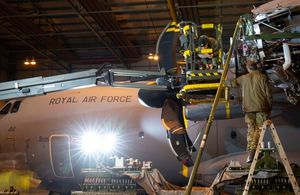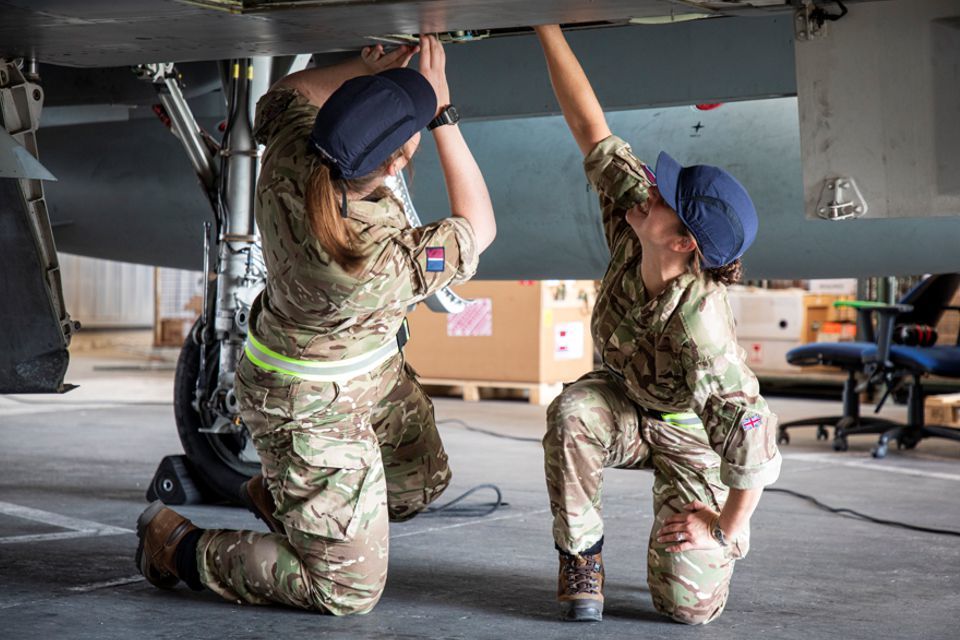Regulatory Article (RA) 4809: Acceptance of Components – what’s all the change about?
RA 4809 has changed a lot recently; this article explains why it has changed, where it’s going and addresses some common misconceptions.

RAF engineers complete A400M engine change in the South Atlantic. MOD Crown Copyright.
Did you know…
RA 4809 has changed a lot recently; this article explains why it changed, where it’s going and tries to address some common misconceptions.
Historically we’ve not been good at requiring the right documentation for Aviation components, especially for Standard Parts (nuts, bolts, washers etc). Without the right documentation, non-aviation parts could be, and have been, fitted to aircraft, as found in MAA Audits.
There’s an ocean of parts out there with sub-standard documentation and we need to stop adding to it. The changes to RA 4809 are intended to make sure that we can all be confident that only safe and airworthy parts are fitted to aircraft.
What are the changes?
RA 4809 Issue 7 (November 2021) changes have included:
- Certificate of Conformities (CoC) being permitted for new components only - this is moving closer to CAA Regulation
- MOD Form 3910s require the asterisked elements to be completed in the case of Airworthy Certified Items
- MOD Form 640s have been removed from Acceptable Means of Compliance
What’s coming next?
RA 4809 Issue 8 (November 2022) changes have included:
- a complete restructure to simplify the way that components are classified and the appropriate acceptance documentation
- CoCs should be from the Original Equipment Manufacturer (OEM) and for new components only
- introduces the 8 requirements of an Authorised Release Certificate (ARC)
- ARCs should be used for components following test, maintenance, modification, overhaul or repair
Misconception 1
MOD Form 640s can’t be used as a CoC.
Reality: MOD Form 640s can be used as a CoC, if they contain DEFCON 627 information. MOD Form 640s currently within the system are valid CoCs if they contain the relevant DEFCON 627 information. However, the Regulated Community are discouraged from using MOD Form 640s as new CoCs, due to the disparity of retention periods. If MOD Form 640s are being used as CoCs, they are to be retained for a minimum of 5 years beyond the Out of Service Date. Logistic retention policy requires MOD Form 640s to be retained for only 7 years. This has led to confusion and disposal of MOD Form 640s, used as CoCs.
Misconception 2
ARCs can’t be used for new components.
Reality: ARCs can be used for new and used (tested, inspected, repaired or overhauled) components. It is only CoCs that are limited to being used for new components only.
- an annex will be added, that details the list of forms that the MAA recognises that meets these 8 requirements
Why are these changes being made?
Civil Regulation is more straightforward than the MAA’s Regulation on the acceptance of components. The Civil Aviation Authority (CAA) allows only the use of Aviation Authority approved forms, e.g. CAA Form 1.
Misconception 3
Civil aviation permits the use of CoCs for used components.
Reality: The CAA and the European Union Aviation Safety Agency (EASA) only allow CoCs for new Standard Parts, as per Regulation 145.A.42(a)(iv)]:
CAA 145.A.42:
- Classification of components. All components shall be classified into the following categories:
- Components which are in a satisfactory condition, released on a CAA Form 1 or equivalent and marked in accordance with Subpart Q of the Annex I (Part 21) to Regulation (EU) No 748/2012, unless otherwise specified in Annex I (Part 21) to Regulation (EU) No 748/2012 or in this Annex II (Part 145).
- Unserviceable components which shall be maintained in accordance with this Regulation.
- Components categorised as unsalvageable because they have reached their mandatory life limitation or contain a non-repairable defect.
- Standard Parts used on an aircraft, engine, propeller or other aircraft component when specified in the maintenance data and accompanied by evidence of conformity traceable to the applicable standard.
- Material, both raw and consumable, used in the course of maintenance when the organisation is satisfied that the material meets the required specification and has appropriate traceability. All material shall be accompanied by documentation clearly relating to the particular material and containing a conformity to specification statement as well as the manufacturing and supplier source.
The CAA is able to take this approach as Maintenance Organisations only accept components from Part 21 and Part 145 approved organisations. The military environment isn’t as simple. RA 1005 – Contracting with Component Organisations, does not have the same requirement for all Maintenance to be carried out by Maintenance Approved Organization Scheme (MAOS) (or equivalent) approved organisations. This provides Delivery Teams with the flexibility to contract with required organisations. This has previously seen unapproved organisations provide components, both new and repaired, with a CoC. The minimum requirements of a CoC do not include the vital information for repaired components, such as “lifing” information. CoCs do not provide the same detail of airworthiness information as an ARC. This is why the extra requirements for an ARC are being introduced to clarify and standardise this information. It is also why CoCs are not allowed for repaired components.
The reason only OEM CoCs will be allowed, is to minimise the opportunity for human errors to be made if information was to be transferred to new documentation. It also increases the chances of the traceability being maintained.
The RA is being restructured for simplification. Having 8 requirements for an ARC detailed in RA 4809, means that organisations are able to determine if their documentation meets the requirements of an ARC. If it doesn’t, it’s possible for people to easily identify where the shortfalls are, and the risk associated with the shortfalls. This will aid Alternative Acceptable Means of Compliance, Waiver and Exemption applications.

Two Royal Air Force Engineering Officers inspect a RAF Typhoon as it undergoes essential maintenance. MOD Crown Copyright.
What does this mean?
The changes to RA 4809 will mean that unapproved organisations (not MAOS or CAA/EASA Part 21/145 approved organisations), releasing repaired components on non-acceptable forms, will have to apply for Alternative Acceptable Means of Compliance, Waivers or Exemptions (AWE). Applications should be made in accordance with MAA03: MAA regulatory processes. They will have to prove to the MAA that their documentation meets the requirements of an ARC. The eighth requirement will be the most difficult for these organisations to meet:
Be issued under Part 21 or 145 authority of the MAA or an Aviation Authority for which the MAA holds an extant Recognition, or for which there exists an extant UK bi-lateral agreement for items that have dual applicability.
It is through the AWE process that the MAA will provide this assurance and will carry out periodic reviews on the AWE throughout its lifespan.
There is an alternative method for organisations to comply with RA 4809. If an organisation has the sufficient knowledge of its subcontractor’s components, then under the privileges of the organisation, it may release the component under its own Approval and their own ARC. RA 4812 - Certification of Air System Release and Component Release, provides more detail. Note that this RA is being updated in November 2022 to make the information about Contracting and Sub-contracting clearer.
Feedback
RA 4809 Issue 8 has had 3 Notice of Proposed Amendments (NPA) to allow the Regulatory Community to view the changes. Note that the third NPA finished 26 September 2022, but feedback and discussion are always welcomed.
In November 2023, there will be a Post Implementation Review of RA 4809, so feedback after the changes have been made, will be reviewed.
All enquiries can be sent to DSA-MAA-MRPenquiries@mod.gov.uk.
Going Forward
The MAA recognises that the changes to RA 4809 will require time to amend contracts and may not be economically appropriate for some organisations, given some Air System Out of Service Dates. This will require AWEs applications to cover any non-compliance, whether temporary or permanent.
The overarching aim of the changes is to improve Air Safety by providing greater traceability of parts and evidence that components are airworthy. This has been likened, by some, to attempting to drink the ocean. But for us to get anywhere we first need to turn off all the taps feeding into it; only then, together, we can do it!